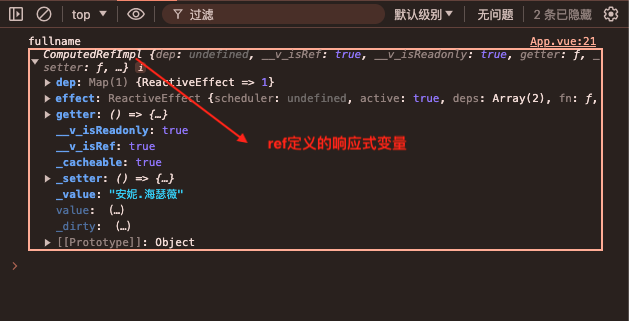vue3.x之计算属性与侦听器
计算属性
我们一般使用计算属性来描述依赖响应式状态的复杂逻辑。
计算属性的用法
在vue3中计算属性的用法和在vue2中的不一样。
<template> <div>姓名:{{ fullname }}</div> </template> <script lang="ts"> //👀:需要什么导入什么 import { reactive,computed } from 'vue' export default { name: 'App', //setup函数是组合式API的入口函数,调用在beforeCreated之前 setup() { //1.定义响应式属性 const person = reactive({ firstName:'安妮', lastName:'海瑟薇' }); //2.定义计算属性 const fullname = computed(()=>{ return `${person.firstName}.${person.lastName}`; }) console.log('fullname',fullname) return { person, fullname} } } </script>
效果如下:

从上述效果图中我们可以看出,计算属性返回的变量相当于是一个使用ref定义的响应式变量。需要通过.value来获取值。
计算属性的完整用法
const fullname = computed({ //输入一个包含set和get的配置对象 get() { return `${person.firstName}·${person.lastName}`; }, // setter set(newValue) { // 注意:我们这里使用的是解构赋值语法 [person.firstName, person.lastName] = newValue.split(' ') } });
👀 计算属性除了定义可读,它也可以设置可写(不建议)。
计算属性的使用场景
我们一般使用计算属性都是对复杂的可读的属性想要响应式,只采用可读。
侦听器
和vue2一样,我们可以使用 watch 函数在每次响应式状态发生变化时触发回调函数。 由于vue3中数据分为基本类型和复杂类型的响应式数据,因此在使用watch监听的时候也分为以下几种。
watch监听ref
//👀:需要什么导入什么 import { ref,watch } from 'vue' export default { name: 'App', //setup函数是组合式API的入口函数,调用在beforeCreated之前 setup() { //1.定义响应式属性 const a = ref(0) const b = ref(0) //2.定义侦听器 //监听单个ref watch(a,(newval)=>{ console.log(`a is ${newval}`); }) //使用getter监听 watch(()=> a.value + b.value,(sum)=>{ console.log(`sum of a + b is: ${sum}`) }) //监听多个来源组成的数组 watch([a, ()=>b.value],([newA, newy])=>{ console.log(`a is ${newA} and b is ${newy}`); }) return {} } }
watch监听props属性
//👀:需要什么导入什么 import {watch } from 'vue' export default { name: 'App', props:{name:{type:String,default:''}}, //setup函数是组合式API的入口函数,调用在beforeCreated之前 setup(props) {//1.定义侦听器 //监听单个props watch(()=>props.name,(newval)=>{ console.log(`name is ${newval}`); }) return {} } }
watch监听对象
watch监听对象的属性的时候需要用一个返回该属性的 getter 函数:
//👀:需要什么导入什么 import { reactive, watch } from 'vue' export default { name: 'App', //setup函数是组合式API的入口函数,调用在beforeCreated之前 setup() { //1.定义响应式对象 const person = reactive({ name: '' }) //2.定义侦听器 //监听单个reactive对象 watch(() => person.name, (newval) => { console.log(`name is ${newval}`); }) return { person } } }
如果用下列watch监听对象,必须是直接给person重新赋值才能被监听
//👀:需要什么导入什么 import { reactive, watch } from 'vue' export default { name: 'App', //setup函数是组合式API的入口函数,调用在beforeCreated之前 setup() { //1.定义响应式对象 const person = reactive({ name: '', age: 18 }) //2.定义侦听器 //监听单个reactive对象 watch(() => person, (newval) => { console.log(`person is ${newval}`); }) return { person } } }
深度监听
如果想监听上述person对象,只要里面任意属性改变都能监听到的话,就需要使用深度监听。
//👀:需要什么导入什么 import { reactive, watch } from 'vue' export default { name: 'App', //setup函数是组合式API的入口函数,调用在beforeCreated之前 setup() { //1.定义响应式对象 const person = reactive({ name: '', age: 18 }) //2.定义侦听器 //监听单个reactive对象 watch(() => person, (newval) => { console.log(`person is ${newval}`); }, { deep: true }) return { person } } }
即时监听
watch 默认是懒执行的:仅当数据源变化时,才会执行回调。但在某些场景中,我们希望在创建侦听器时,立即执行一遍回调。那么就需要使用immediate: true来配置
//👀:需要什么导入什么 import { reactive, watch } from 'vue' export default { name: 'App', //setup函数是组合式API的入口函数,调用在beforeCreated之前 setup() { //1.定义响应式对象 const person = reactive({ name: '', age: 18 }) //2.定义侦听器 //监听单个reactive对象 watch(
() => person,
(newval) => {console.log(`person is ${newval}`);},
{deep: true, immediate:true})
return { person }
}
}





 浙公网安备 33010602011771号
浙公网安备 33010602011771号